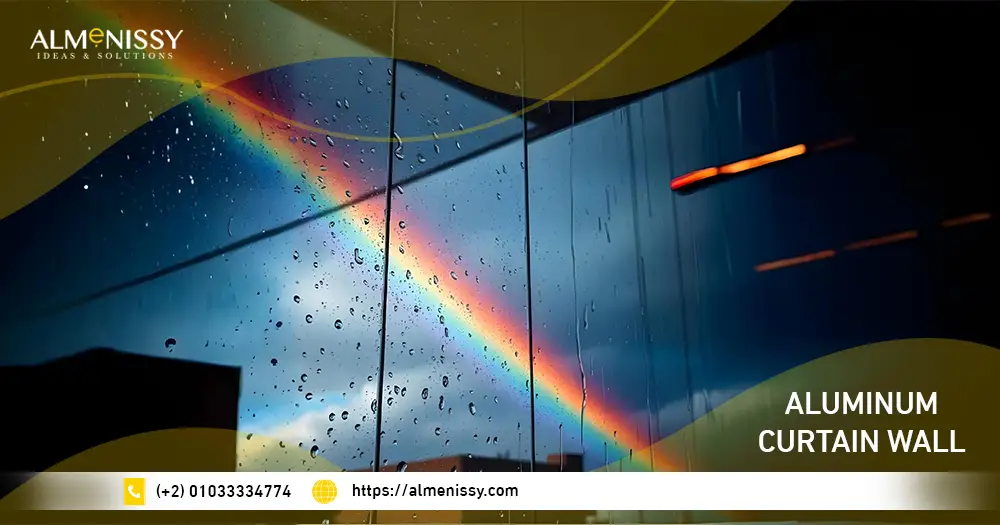Aluminum curtain wall is an architectural innovation that reflects the evolution of modern design and meets the needs of modern buildings. This type of wall is characterized by its lightness and strength, making it an ideal choice for glass facades that enhance the aesthetics of buildings and give them an elegant and modern appearance.
Aluminum curtain wall provide effective thermal and sound insulation, which contributes to improving the comfort of residents and reducing energy consumption. They also have great design flexibility, allowing architects to achieve their creative visions smoothly. In a world moving towards sustainability and beauty, aluminum curtain wall remains a strategic choice for commercial and residential buildings alike.
Table of Contents
What Is Aluminum Curtain Walling?
Aluminum curtain wall is a structural system used in the design of the exterior facades of buildings, where it is installed in a way that allows the installation of glass panels or other materials, creating an attractive and modern facade. This system consists of a frame made of aluminum, which is characterized by its lightness and durability, making it ideal for supporting large glass panels without the need for additional support.
Curtain walls are often used in commercial and high-rise buildings, where they help bring natural light into interior spaces and provide effective thermal and sound insulation. Thanks to their customizable properties, aluminum curtain walls can be designed in a variety of shapes and colors, giving architects the freedom to be creative and enhancing the aesthetics of buildings.
How Thick Does Aluminum Need To Be For A Curtain Wall?
The appropriate thickness of aluminum used in aluminum curtain wall is a vital element that affects the strength and sustainability of the structural system. The required thickness of aluminum usually ranges from 1.5 to 3.0 mm, depending on several factors, including the size of the glass panels, air pressure, and thermal and acoustic performance requirements. The thicker the thickness, the stronger the aluminum is and its ability to withstand environmental stresses and climate changes.
Which contributes to enhanced safety and stability. However, a balance must be taken into account between thickness and weight, as excessive use of thickness can increase the overall weight of the wall, requiring additional engineering designs to ensure structural stability. Therefore, choosing the optimal thickness requires careful consideration of the surrounding conditions and architectural design needs.
What Is The Difference Between A Window Wall And An Aluminum Curtain Wall?
The difference between a window wall and an aluminum curtain wall is essential in the world of architectural design, as each is used for different purposes and has distinct characteristics. A window wall is usually part of the main structure of a building, while windows are considered part of load-bearing walls, meaning they can bear weight and pressure.
While an aluminum curtain wall is a non-load-bearing system, consisting of a metal frame that is attached to the exterior structure of the building, and relies on glass panels or other materials to form the facade.
The curtain wall allows the weight to be distributed to the lower floor, allowing for the design of large glass facades that allow natural light to enter, without affecting the main structure of the building. In addition, the curtain wall is more flexible in design, giving architects more freedom to create innovative artistic forms, while window walls are limited by structural factors and supports.
What Is The Purpose Of An Aluminum Curtain Wall?
The purpose of an aluminum curtain wall goes beyond being an aesthetic element in architectural design; it plays a vital role in improving the performance of buildings. One of the main purposes of curtain walls is to provide effective thermal and sound insulation, which contributes to enhancing the comfort of residents and reducing energy consumption.
Thanks to its strong metal composition and lightness, the curtain wall can support large glass panels, allowing for the design of wide glass facades that reflect natural light and enhance the external views. This system also helps protect buildings from environmental elements such as wind and rain.
Which enhances the life and sustainability of the building. By offering flexible design options, the curtain wall allows architects to be creative in shaping facades, making it a popular choice for modern commercial and residential buildings.
What Metal Is Used For Aluminum Curtain Wall?
The main metal used in curtain wall is aluminum, which is considered an ideal choice due to its unique properties. Aluminum is lightweight compared to other metals, which facilitates the installation process and reduces the burden on the building’s basic structure.
In addition, aluminum has a high resistance to corrosion, making it suitable for various environmental conditions without the need for extensive maintenance. Aluminum alloys are commonly used in the manufacture of curtain walls, as these alloys enhance the strength and rigidity.
Which contributes to ensuring the safety and stability of the structure. Aluminum can also be easily formed, allowing the design of complex and flexible geometric shapes that enhance the aesthetics of facades and contribute to improving the efficiency of buildings in terms of thermal and sound insulation.
Conclusion
In conclusion, According to Alminssy Company, aluminum curtain wall system is an ideal choice in modern building design, combining architectural beauty with functional benefits. Thanks to its lightweight and high durability, aluminum reduces structural loads on the building while achieving an attractive and sophisticated appearance.
Aluminum curtain wall also provides effective thermal and sound insulation, enhancing energy efficiency and ensuring a comfortable indoor environment. With continuous advancements in technology, aluminum curtain wall systems continue to meet architectural and environmental requirements, making them a reliable and sustainable choice for future buildings.
FAQ
What Is The Application Of Aluminum Curtain Wall?
The aluminum curtain wall are used to cover building facades, providing protection against weather elements like wind and rain. They contribute to enhancing the building's exterior appearance while offering thermal and sound insulation.
Where Are Aluminum Curtain Walls Used?
Aluminum curtain wall are primarily used in commercial buildings and skyscrapers, where they cover glass facades to provide protection, insulation, and enhance the exterior appearance.


